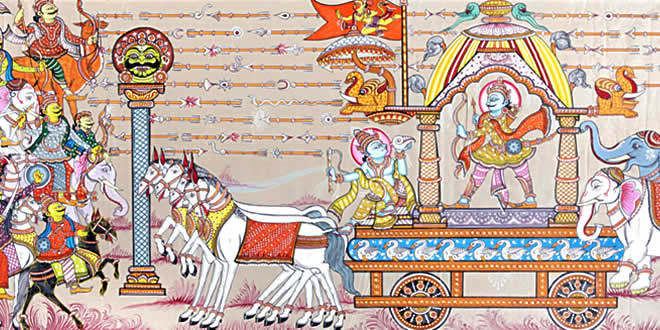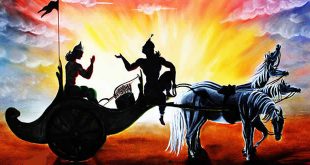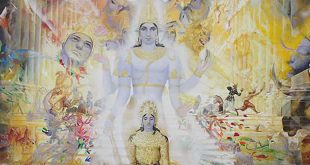Moksa Opadesa Yoga: Bhagavad Gita Chapter 18 [Final Revelations of the Ultimate Truth]
Sanjaya Said > Shaloka: 78
![Moksa Opadesa Yoga: Bhagavad Gita [Chapter: 18 - Verse 78]](https://www.4to40.com/wp-content/uploads/2015/01/18_shaloka_078.gif)
English
Wherever there is Krishna, the master of all mystics, and wherever there is Arjuna, the supreme archer, there will also certainly be opulence, victory, extraordinary power, and morality. That is my opinion.
Purport
The Bhagavad-gita began with an inquiry of Dhrtarastra. He was hopeful of the victory of his sons, assisted by great warriors like Bhisma, Drona and Karna. He was hopeful that the victory would be on his side. But, after describing the scene on the battlefield, Sanjaya told the King, “You are thinking of victory, but my opinion is that where Krishna and Arjuna are present, there will be all good fortune.” He directly confirmed that Dhrtarastra could not expect victory for his side. Victory was certain for the side of Arjuna because Krishna was there. Krishna’s acceptance of the post of charioteer for Arjuna was an exhibition of another opulence. Krishna is full of all opulences, and renunciation is one of them. There are many instances of such renunciation, for Krishna is also the master of renunciation.
The fight was actually between Duryodhana and Yudhisthira. Arjuna was fighting on behalf of his elder brother, Yudhisthira. Because Krishna and Arjuna were on the side of Yudhisthira, Yudhisthira’s victory was certain. The battle was to decide who would rule the world, and Sanjaya predicted that the power would be transferred to Yudhisthira. It is also predicted here that Yudhisthira, after gaining victory in this battle, would flourish more and more because he was not only righteous and pious, but he was a strict moralist. He never spoke a lie during his life.
There are many less intelligent persons who take Bhagavad-gita to be a discussion of topics between two friends in a battlefield. But such a book cannot be scripture. Some may protest that Krishna incited Arjuna to fight, which is immoral, but the reality of the situation is clearly stated: Bhagavad-gita is the supreme instruction in morality. The supreme instruction of morality is stated in the Ninth Chapter, in the thirty-fourth verse: man-mana bhava mad-bhaktah. One must become a devotee of Krishna, and the essence of all religion is to surrender unto Krishna, as stated, Sarva-dharman. The instructions of Bhagavad-gita constitute the supreme process of religion and of morality. All other processes may be purifying and may lead to this process, but the last instruction of the Gita is the last word in all morality and religion: surrender unto Krishna. This is the verdict of the Eighteenth Chapter.
From Bhagavad-gita we can understand that to realize oneself by philosophical speculation and by meditation is one process, but to fully surrender unto Krishna is the highest perfection. This is the essence of the teachings of Bhagavad-gita. The path of regulative principles according to the orders of social life and according to the different courses of religion may be a confidential path of knowledge in as far as the rituals of religion are confidential, but one is still involved with meditation and cultivation of knowledge. Surrender unto Krishna in devotional service in full Krishna consciousness is the most confidential instruction and is the essence of the Eighteenth Chapter.
Another feature of Bhagavad-gita is that the actual truth is the Supreme Personality of Godhead, Krishna. Absolute Truth is realized in three features–impersonal Brahman, localized Paramatma, and the Supreme Personality of Godhead, Krishna. Perfect knowledge of the Absolute Truth means perfect knowledge of Krishna. If one understands Krishna, then all the departments of knowledge are part and parcel of that understanding. Krishna is transcendental, for He is always situated in His eternal internal potency. The living entities are manifested and are divided into two classes, eternally conditioned and eternally liberated. Such living entities are innumerable, and they are considered fundamental parts of Krishna. Material energy is manifested into twenty-four divisions. The creation is effected by eternal time, and it is created and dissolved by external energy. This manifestation of the cosmic world repeatedly becomes visible and invisible.
In Bhagavad-gita five principal subject matters have been discussed: the Supreme Personality of Godhead, material nature, the living entities, eternal time and all kinds of activities. All of these are dependent on the Supreme Personality of Godhead, Krishna. All conceptions of the Absolute Truth, namely, impersonal Brahman, localized Paramatma, or any other transcendental conception, exist within the category of understanding the Supreme Personality of Godhead. Although superficially the Supreme Personality of Godhead, the living entity, material nature and time appear to be different, nothing is different from the Supreme. But the Supreme is always different from everything. Lord Caitanya’s philosophy is that of “inconceivably one and different.” This system of philosophy constitutes perfect knowledge of the Absolute Truth.
The living entity in his original position is pure spirit. He is just like an atomic particle of the Supreme Spirit. The conditioned living entity, however, is the marginal energy of the Lord; he tends to be in contact with both the material energy and the spiritual energy. In other words, the living entity is situated between the two energies of the Lord, and because he belongs to the superior energy of the Lord, he has a particle of independence. By proper use of that independence he comes under the direct order of Krishna. Thus he attains his normal condition in the pleasure-giving potency.
Thus end the Bhaktivedanta Purports to the Eighteenth Chapter of the Srimad Bhagavad-gita in the matter of its Conclusion–the Perfection of Renunciation.
Hindi
![Moksa Opadesa Yoga: Bhagavad Gita [Chapter: 18 - Verse 78]](https://www.4to40.com/wp-content/uploads/2015/01/18_shaloka_078_hindi.gif)
Punjabi
![Moksa Opadesa Yoga: Bhagavad Gita [Chapter: 18 - Verse 78]](https://www.4to40.com/wp-content/uploads/2015/01/18_shaloka_078_punjabi.gif)
 Kids Portal For Parents India Kids Network
Kids Portal For Parents India Kids Network


